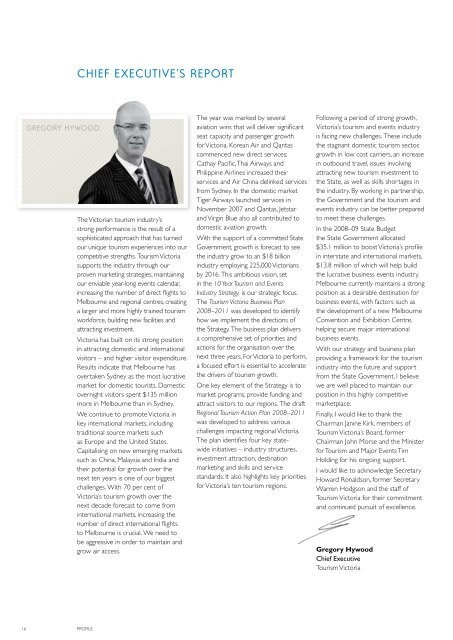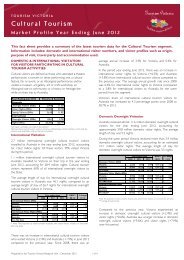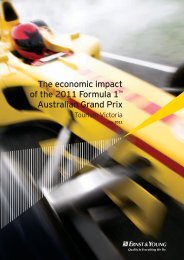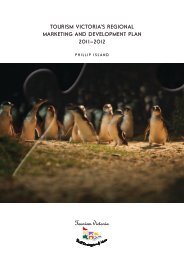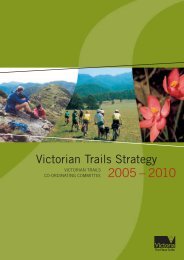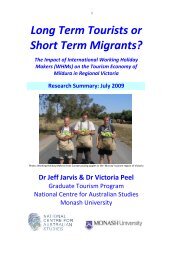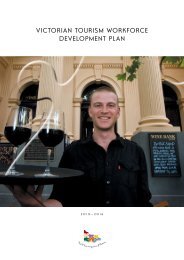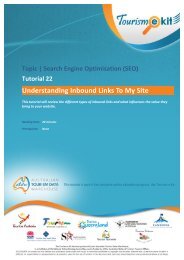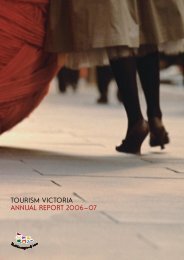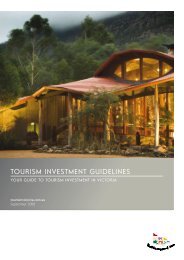TOURISM VICTORIA ANNUAL REPORT
TOURISM VICTORIA ANNUAL REPORT
TOURISM VICTORIA ANNUAL REPORT
You also want an ePaper? Increase the reach of your titles
YUMPU automatically turns print PDFs into web optimized ePapers that Google loves.
chief executive’s report<br />
gregory hywood<br />
The Victorian tourism industry’s<br />
strong performance is the result of a<br />
sophisticated approach that has turned<br />
our unique tourism experiences into our<br />
competitive strengths. Tourism Victoria<br />
supports the industry through our<br />
proven marketing strategies, maintaining<br />
our enviable year-long events calendar,<br />
increasing the number of direct flights to<br />
Melbourne and regional centres, creating<br />
a larger and more highly trained tourism<br />
workforce, building new facilities and<br />
attracting investment.<br />
Victoria has built on its strong position<br />
in attracting domestic and international<br />
visitors – and higher visitor expenditure.<br />
Results indicate that Melbourne has<br />
overtaken Sydney as the most lucrative<br />
market for domestic tourists. Domestic<br />
overnight visitors spent $135 million<br />
more in Melbourne than in Sydney.<br />
We continue to promote Victoria in<br />
key international markets, including<br />
traditional source markets such<br />
as Europe and the United States.<br />
Capitalising on new emerging markets<br />
such as China, Malaysia and India and<br />
their potential for growth over the<br />
next ten years is one of our biggest<br />
challenges. With 70 per cent of<br />
Victoria’s tourism growth over the<br />
next decade forecast to come from<br />
international markets, increasing the<br />
number of direct international flights<br />
to Melbourne is crucial. We need to<br />
be aggressive in order to maintain and<br />
grow air access.<br />
The year was marked by several<br />
aviation wins that will deliver significant<br />
seat capacity and passenger growth<br />
for Victoria. Korean Air and Qantas<br />
commenced new direct services;<br />
Cathay Pacific, Thai Airways and<br />
Philippine Airlines increased their<br />
services and Air China delinked services<br />
from Sydney. In the domestic market<br />
Tiger Airways launched services in<br />
November 2007 and Qantas, Jetstar<br />
and Virgin Blue also all contributed to<br />
domestic aviation growth.<br />
With the support of a committed State<br />
Government, growth is forecast to see<br />
the industry grow to an $18 billion<br />
industry employing 225,000 Victorians<br />
by 2016. This ambitious vision, set<br />
in the 10 Year Tourism and Events<br />
Industry Strategy, is our strategic focus.<br />
The Tourism Victoria Business Plan<br />
2008–2011 was developed to identify<br />
how we implement the directions of<br />
the Strategy. The business plan delivers<br />
a comprehensive set of priorities and<br />
actions for the organisation over the<br />
next three years. For Victoria to perform,<br />
a focused effort is essential to accelerate<br />
the drivers of tourism growth.<br />
One key element of the Strategy is to<br />
market programs, provide funding and<br />
attract visitors to our regions. The draft<br />
Regional Tourism Action Plan 2008–2011<br />
was developed to address various<br />
challenges impacting regional Victoria.<br />
The plan identifies four key statewide<br />
initiatives – industry structures,<br />
investment attraction, destination<br />
marketing and skills and service<br />
standards. It also highlights key priorities<br />
for Victoria’s ten tourism regions.<br />
Following a period of strong growth,<br />
Victoria’s tourism and events industry<br />
is facing new challenges. These include<br />
the stagnant domestic tourism sector,<br />
growth in low cost carriers, an increase<br />
in outbound travel, issues involving<br />
attracting new tourism investment to<br />
the State, as well as skills shortages in<br />
the industry. By working in partnership,<br />
the Government and the tourism and<br />
events industry can be better prepared<br />
to meet these challenges.<br />
In the 2008–09 State Budget<br />
the State Government allocated<br />
$35.1 million to boost Victoria’s profile<br />
in interstate and international markets,<br />
$13.8 million of which will help build<br />
the lucrative business events industry.<br />
Melbourne currently maintains a strong<br />
position as a desirable destination for<br />
business events, with factors such as<br />
the development of a new Melbourne<br />
Convention and Exhibition Centre,<br />
helping secure major international<br />
business events.<br />
With our strategy and business plan<br />
providing a framework for the tourism<br />
industry into the future and support<br />
from the State Government, I believe<br />
we are well placed to maintain our<br />
position in this highly competitive<br />
marketplace.<br />
Finally, I would like to thank the<br />
Chairman Janine Kirk, members of<br />
Tourism Victoria’s Board, former<br />
Chairman John Morse and the Minister<br />
for Tourism and Major Events Tim<br />
Holding for his ongoing support.<br />
I would like to acknowledge Secretary<br />
Howard Ronaldson, former Secretary<br />
Warren Hodgson and the staff of<br />
Tourism Victoria for their commitment<br />
and continued pursuit of excellence.<br />
Gregory Hywood<br />
Chief Executive<br />
Tourism Victoria<br />
16 PROFILE


